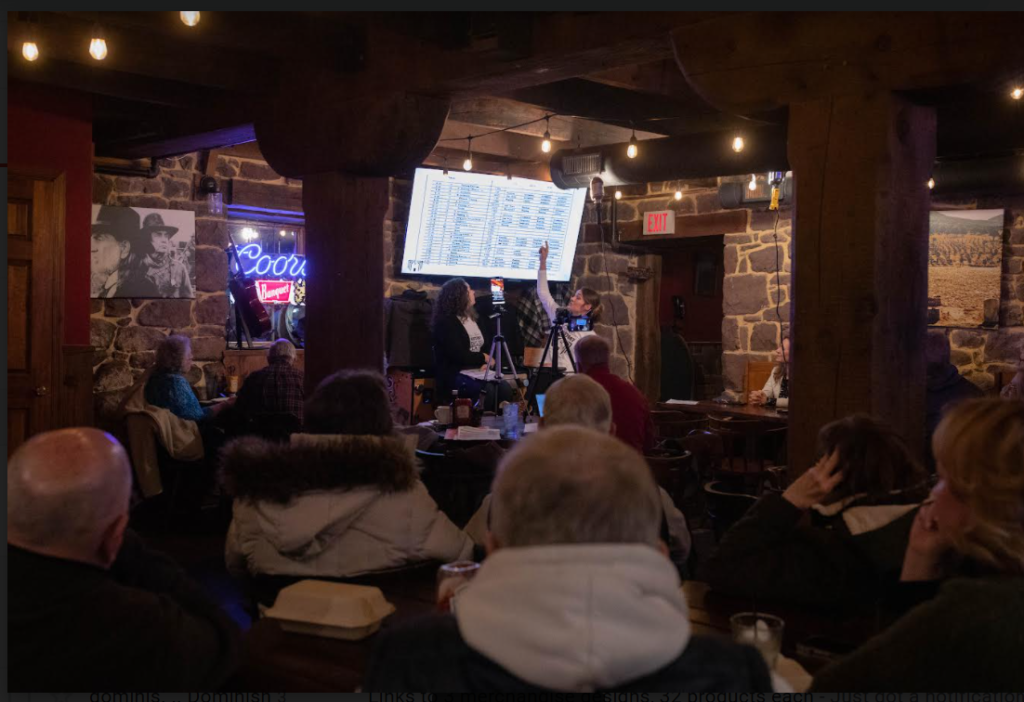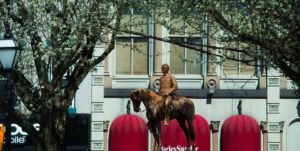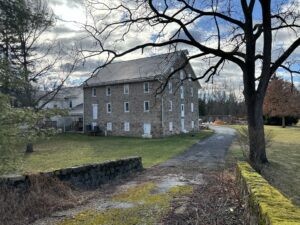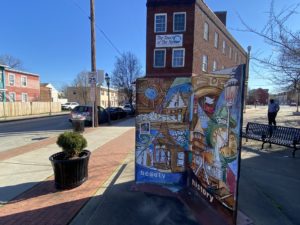Jamie and Domi’s York County history: Season 2
Newberrytown
Village of Newberrytown, York County
The situation – Season 2
In Season 2, Episode 1 of “Hometown History: Jamie and Domi’s YoCo Backstory,” Jamie Kinsley and Dominish Marie Miller explore York County’s love affair with one-room schools: “All in one room: These small schools taught big lessons.”
Description: Those were the days when everyone in class drank from the same cup. When the teacher smacked the hands of southpaws, trying to ensure they learned the “right” way. When an orange that came at Christmas was as coveted as a cell phone today. Talk about one-room schools with former students, and you’ll soon be awash in memories. And strong opinions about getting back to basics in today’s schools. At one point before consolidation in the 1950s, York County led the state in public one-room schools with north of 350 dotting the countryside. Then consolidation set in. Small buildings, they were. But places with outsized influences, even today.
Episode 1, was livestreamed in the Retro York and Preserving the History of Newberrytown Facebook groups at 7 p.m., Thursday, Jan. 20. The show was presented before a live audience at Blue Sky Tavern in Newberry Township.
Jamie, a teacher, holds a doctorate in American studies, blogs about local history and culture and operates this digital site, WitnessingYork.com. Domi, a federal court archivist, holds a master’s degree in library science and local history and moderates the Preserving the History of Newberrytown Facebook group. She is a re-enactor in the 87th Pennsylvania.
Here are some of the goals driving Jamie and Domi and “Hometown History,” complete with a YouTube channel:
- To introduce next generations of York County residents to York County history.
- In so doing, present the history of all people in a way that has weight and is winsome
- To test, refine and practice a conversational way of storytelling about history.
In Season 2, Episode 2 – Jamie and Domi explore York County’s deep history in textiles: “Stitching secret messages: Fabrics and fiber arts in York County’s homes and factories.”
Description: It is said that quilts have served as a creative outlet for otherwise voiceless women. The same could be said about all the colorful, useful and necessary fabrics women crafted with their hands from the Susquehanna region’s earliest days. In this edition of Hometown History, Jamie Kinsley and Domi Miller give voice to women who created – who create – for aesthetics or need. They are using the York County book “Quilts, The Fabric of Friendship” as a resource. And they are drawing on the expertise of northeastern York County’s Red Stone Glen Fiber Arts Center to weave stories about how textiles interlock with the larger York County story.
Episode 2: Filmed at 7 p.m., 2/25, the Red Stone Glen Fiber Arts Center, a Facebook Live only event.
In Season 2, Episode 3, Jamie and Domi talk about “Bridging the Susquehanna: Ice, fire, wind and man destroyed four spans. Two long bridges stand tall.”
Description: “How the new bridge stretches its pride of length across the wide Susquehanna!” Methodist circuit rider Francis Asbury wrote about the 1814 bridge spanning the wide river between Wrightsville and Columbia. “Will not the father of eastern waters some day rise in the fury of a winter flood, and tear away this slight fetter which the puny art of man has thrown over him?”
As the good bishop predicted, an ice jam destroyed the bridge in 1832. Five bridges follow this wooden covered bridge connecting Columbia and Wrightsville, all part of the story of the river towns and their river.
Episode 3: Filmed before a live audience at 7 p.m. March 31, at the Burning Bridge Tavern, Wrightsville. With Codie Eash of Gettysburg’s Seminary Ridge Museum.
In Season 2, Episode 4, Jamie and Domi talk about “Hellam’s Horn Farm: Growing the Three Sisters, Imperial apples and George’s favorite pawpaw dessert.”
Description: The Horn Farm is taking center row as Hometown History showcases YoCo’s agriculture history. Jamie and Domi explore 3 lessons taught through 3 crop combos, all rooted in county history and still grown at Hellam Township’s Horn Farm. They provide a taste of the three-sister grains planted by Native Americans, long-lasting Imperial apple and flavorful pawpaws. The Horn farm does much more than preserve York County agricultural history. It practices it. And is doing so amid adversity. A 2021 lightning strike claimed most of its historic farmhouse. And a truck stop wants to plant operations a field away. Still, a farmhouse rebuild is planned. “Let the ashes of this tragedy,” the Horn Farm says, “be fertile soil for our future growth and resilient community.”
Episode 4: Filmed at 7 p.m. April 28, at the Horn Farm Center, Hellam Townhip. An interview with Zach Routson, a local grower, served as a Hometown History Extra.
See all six Season 1 episodes, with show notes: Hometown History.
Season 2, Episode 5: Jamie and Domi talk about “We walk the line: On the rail trail from New Freedom to York, Pa.”
Description: Walk with us along the York County Heritage Rail Trail, following the path of the 19th-century Northern Central Railway. Let’s start at the Maryland line and particularly take in the towns along the way – New Freedom, Railroad, Glen Rock, Seven Valleys and York. These are towns that are finding renewed energy from rail trail users like us. We stop, talk, shop and appreciate these old towns. And importantly, these towns remain the place where York County’s people live, work, worship and play. They are places that have seen a lot and offered much, making the map or receiving a boost when this old railroad corridor first punched through from Baltimore in 1838. And this ribbon of a county park – the 27-mile rail trail – will be tied when its northern and southern sections meet in York this summer. At that point, New Freedom in York County’s south will shake hands with Manchester Township in its northeast, drawing two key regions of the county more closely together in the way the old Northern Central knit York and Baltimore. In partnership with the York County Economic Alliance. Civil War historian Scott Mingus joined Jamie and Domi for a Hometown History Extra discussing railroads in York County, particularly the Northern Central Railway. Jamie and Domi also produced a short video about the Howard Tunnel. See all these videos on Hometown History’s YouTube channel.
Episode 5: Filmed at 7 p.m. May 24, at The Creek House, Railroad borough. Interview with Scott Mingus served as Hometown History Extra.
Season 2, Episode 6: Jamie and Domi talk about Tropical Storm Agnes on its 50th anniversary in “We walk the line: On the rail trail from New Freedom to York, Pa.”
Description: With weird weather events happening all over the world, an excursion through York County’s floods suggests that weather has been a foe many times in history. York County is a well-watered place. Which means it has seen prosperity in agriculture and industry. Which means when the weather is severe the threat of flood is real. Actually, it’s not a threat. It has happened regularly since we’ve started tracking such things in the 1700s. Tropical Storm Agnes was the county’s worst among floods in 1884, 1933 and 1936. At least 4 dead and millions in property damage. Hometown History Extra: Author Sandra L. Stockton was part of the evening, recounting her experiences in getting caught in the storm and cleaning up after Agnes.
Episode 6: This event took place before in-person and streamed audiences at the Burning Bridge Tavern in Wrightsville – a Trail Town in partnership with York County Economic Alliance.
Season 2, Episode 7 – Jamie and Domi talk about the making of wire cloth – screening – in York County and its worldwide impact: “Summertime in YoCo: Trolley whistles, bugs and screens.”
Description – In the 1880s, horses — maybe in protest of their tail hair being loomed into sofas — powered a change in the making of horse cloth textiles. Horse power pulled everything around York County in those years. Wagons to factories and railroads. Carriages from houses to opera. Trolleys carrying people and goods. These horses empowered flies. And that caused master weaver John W. Eisenhart to refit his looms from hair cloth to wire cloth. The looms spun out bug wire – screens – for windows to keep bugs out of your soup and gravy. So this is a story of trolleys that begat New York Wire Cloth, home of the York Factory Whistle. And now its rusty factory has been polished into maker’s space – home of a new type of artisans and craftsmen.
Episode 7 – This event took place before in-person and streamed audiences at the restored New York Wire Works in York – an episode in partnership with Trail Towns and York County Economic Alliance.
Season 2, Episode 8 -Jamie and Domi talk about the restored Yorktowne Hotel, to open in the fall of 2022 in: “Yorktowne Hotel: Making memories, meaning and the Green Book.”
Description – Many look back on the Yorktowne Hotel, thinking about weddings and dances in the grand ballroom, special anniversary nights or meeting celebrities in the lobby on their way from performances at the Appell Center or the Valencia. And there’s immense meaning spawned in that tall building, with its 77-foot signature rooftop flagpole. For sure, not everyone had access to those Yorktowne memories and that would start with people of color. When the Yorktowne opened in 1925, Black people could not stay there. After 30 years, the Yorktowne Hotel gained a well-earned entry in the Green Book, a treasure of safe and accepting places for Black people who were traveling to stay. Thirty years later, the hotel banned a white supremacist organization from meeting there. This landmark has long reflected its community. The Yorktowne has presided over York’s post World War II retail zenith and persevered through its downturns. Now, the renovated Yorktowne is a tall part of the downtown’s comeback. Indeed, the Yorktowne story is one of complexity and celebration and now of rebirth – sporting a newly minted Hilton tag and a restoration that will make it a place of memories and meaning for decades to come.
Episode 8 – This event is streamed from the rooftop of the Yorktowne Hotel. an episode in partnership with Trail Towns and the York County Economic Alliance.
Season 2, Episode 9: Jamie and Domi talked about Martin Library and the York County Library System in “Martin Library tricked the Great Depression to offer treats for generations.” The conversation came before a live audience at Martin Library. The Hometown History Extra featured an interview with Library Director Mina Edmondson. Jamie and Domi produced a five-minute video about the colorful past the Kreutz Creek Cemetery.
Description: Halloweeners pushed through the brand new, heavy wooden doors of Martin Library in full costume in 1935. Trick or treating was a thing that night. The tricky launch of a new library at the height of the Great Depression had been successful. And what a treat it was, this new winsome space filled with books as a diversion in this time of need. The Depression was a crusher, to be sure. But for Martin Library and a host or organizations that would become York County icons, the 1930s served as a moment to conceive, birth and grow. York Little Theater, York Symphony and York Chorus trace their beginnings to these times of scarcity. Except at Martin, with its abundant Halloween treats and shelves of books.
Some at that Halloween opening likely remember when this treat of reading was delayed, even in better economic times. About 30 years earlier, some York readers pursued the building of a columned Carnegie Library, a gift from steelmaker Andrew Carnegie. But some leaders kept the purse strings tight, not wanting to pay for the books and other library resources that would spark minds, young and old.
But that was the past, and Martin would become the type of place for people – to imagine and dream. There is a story of a girl who would sit and read near the library’s Turtle Baby fountain and take in the creativity coming from the deft hands of the artist. Years later, the girl remembered the Turtle Baby and sculpted a youngster of her own, a smiling girl. That bronze joins the Turtle Baby Fountain today in Martin Library’s Sensory Garden, visible from the children’s wing – the inspirer and the inspiration sharing beautiful space. That girl, Lorann Jacobs, did more than offer a bronze treat standing in the garden to inspire future generations. Her public art, outside Martin’s doors, has shaped York’s streetscape for a generation – and many more generations to come.
Season 2, Episode 10 – Jamie and Domi talked about Hanover and the Civil War in “Hanover puts its own stamp against Confederate onslaught.” The conversation came before a live audience at the Hanover Area Arts Guild. The Hometown History Extra featured an interview with regional artist Andrew Smith. Jamie and Domi also produced a five-minute video about the lynching of a Black man who accompanied the Confederates on their raid north of the Mason-Dixon Line.
Description: The Hanover Area, by intention or not, has long fashioned itself as an outsider in York County. Indeed, some in that southwestern region sought to form their own county in the early 1800s. In the Civil War era, Hanover on again operated against the grain. Hanoverians voted Republican in a sea of Democratic, anti-Lincoln townships. When the Confederates came calling the first time, in late June 1863, leaders bravely faced off with words against the enemy in the town square – passively or aggressively or maybe a little of both. In contrast, York’s leaders sought out the Confederates to surrender their town that same day. When Confederate Jeb Stuart sent in the cavalry, the town was at its peaceful best, feeding hungry mounted men dressed in blue. When the ensuing battle left 300 casualties, untrained townspeople treated the most painful and severe saber and point-blank pistol wounds. The Hanover Civil War story is a good one, and it’s not forgotten. Memory makers in the Hanover community have installed about 30 outdoor storyboards, many telling this story about when the Confederates came to town and Union horsemen and townspeople were at their best.
Season 2, Episode 11: Jamie and Domi talked about York City Cemetery in “York’s potter’s field: Common ground for separated people.” The conversation took place at the big mausoleum at Prospect Hill Cemetery. The Hometown History Extra featured an interview with Samantha Dorm, member of Friends of Lebanon Cemetery. Jamie and Domi produced a five-minute video about the mysterious circus performer from Fiji, buried in the potter’s field when it was located at College and George in York.
Description: For centuries in York County, when some deceased people could not be identified, had no family or no financial means, they would be interred in City Cemetery. Until the late 1800s, York’s potter’s field, as it was called, lay at South George Street and West College Avenue. When that land – buoyed in value by a rejuvenated Penn Park – was claimed for a new York High, the remains of individuals in potter’s field were disinterred and reburied on former farmland on a remote hilltop in North York. Burial here separated people by class and race from other York area burial grounds. Permanently. So, the potter’s field made famous in the film “It’s a wonderful life?” The York area has one. And work is underway to mark this forgotten burial space and to tell the stories of the fathers and mothers, sons and daughters of York buried there. It’s called Project Penny Heaven, in its fundraising stage, to place a monument York City Cemetery.
The witness, Season 2
Episode 1: Learn more about the story of one-room schools and their impact on York County’s story, past and present.
One-room schools – A way of life in York County’s past – Witnessing York
Schoolhouses of Strinestown and York County numbers – YorksPast (yorkblog.com)
Episode 2: “Stitching secret messages: Fabrics and fiber arts in York County’s homes and factories.”
Museum of Fiber Arts and Textiles teaches area youth.
Jane Keenheel transformed suit samples into a work of art.
Episode 3: “Bridging the Susquehanna: Ice, fire, wind and man destroyed four spans. Two long bridges stand tall.”
Unsung York County Civil War sites to visit.
River Roots: Bridging the Susquehanna.
A Wrightsville woman’s bravery in the Civil War.
York County should never forget the bravery of this Civil War soldier.
Episode 4: “Hellam’s Horn Farm: Growing the Three Sisters, Imperial apples and George’s favorite pawpaw dessert.”
York County’s Horn Farm: ‘A very special living history memorial to those hardy ancestors’ (ydr.com)
Horn Farm Center hopes to rise from the ashes.
Horn Farm rebuilding will honor farmhouse’s history, serve center’s mission
Episode 5: “We walk the line: On the rail trail from New Freedom to York, Pa.”
Railroad Borough: ‘Probably no other town in America has a horse heaven.’
The unsolved York County mystery of locomotive No. 1689.
Episode 6: Agnes at 50: “When it rains, it pours”
Tropical Storm Agnes, 50 years ago: ‘Like something out of the Bible’ (ydr.com)
Agnes left behind ‘mud, dead rats, old tires, and all kinds of trash’ (ydr.com)
480 Codorus Street: A story about soldiering through adversity (ydr.com)
Episode 7: “Summertime in YoCo: Trolley whistles, bugs and screens.”
New York Wire Works: From a horse’s tail to a whistle’s toot to a craftsman’s booth
Photos: Inside the historic New York Wire Company building
Episode 8: “Yorktowne Hotel: Making memories, meaning and the Green Book.”
York, Pa.’s Market Street parking garage tells 50-year tale of change (ydr.com)
Q & A: Yorktowne Hotel renovation progress is coming slow but sure (ydr.com)
Episode 9: “Martin Library tricked the Great Depression to offer treats for generations.”
Martin Library’s $6 million renovation completed in downtown York.
Kreutz Creek Library’s former building gains new life (ydr.com)
Lorann Jacobs among York County’s most prominent sculptors
Episode 10: “Hanover puts its own stamp against Confederate onslaught.”
A forgotten lynching in western York County.
Outdoor storyboards give details about Hanover’s rich past.
Episode 11: “York’s potter’s field: Common ground for separated people.”
Restoring York’s potter’s field: This volunteer practiced do-it-yourself urbanism
Feuding over a baby’s death: When people can’t afford a gravedigger
York’s Potter’s Field exhumations center of early dispute about disease
Related links and sources:
Episode 1: “All in One Room,” published by the York Daily Record, 2008. Stephen H. Smith’s index to York County one-room schools, Yorkblog.com, York County one-room schools. Photos by Shane Lewis Bahn. Episode 2: “Stitching Secret Messages,” York County Quilt Documentation Project and the York County History Center’s book “Quilts, The Fabric of Friendship,” Red Stone Glen Fiber Arts Center and Teaching Museum for the Fiber Arts & Textiles. Episode 3: Scott Mingus’ “Flames Beyond Gettysburg,” and James McClure’s “East of Gettysburg.” Episode 4: June Evans’ history of the Horn Farm: “York County’s Horn Farm: ‘A very special living history memorial to those hardy ancestors’ Episode 5: Scott Mingus’ “Soldiers, Spies & Steam, A History of the Northern Central Railway in the Civil War” and ‘A Carnival of Grief’: The Lincoln Funeral Train in Pennsylvania.” Episode 6: York Daily Record accounts, June 20-29, 1972. Episode 7: Robert D. Horn’s “The History of The New York Wire Cloth Co.,” York County History Center files. Episode 8: Overnight success: The Yorktowne Hotel at 70: Stetler, Polly: Amazon.com: Books. Episode 9: James McClure’s York Town Square blog posts about Martin Library. Episode 10: Scott Mingus’ Flames Beyond Gettysburg.” Amazon.com: Flames Beyond Gettysburg: The Confederate Expedition to the Susquehanna River, June 1863 eBook : Mingus, Scott L.: Kindle Store. Episode 11: A page filled with stories about York City Cemetery (and how to donate to set a memorial marking this burial site): Project Penny Heaven – Witnessing York
The question
One of Jamie and Domi’s goals is to engage the next generation. They’ve found that, if local Facebook audiences are any indication, at least half are above 50 years in age. To fuel local history interest in those south of 50, these videos are meant to reach a broader audience, interesting people of all ages in York County history. However, this is just the first step. How else can we get our kids and grandkids into history?

— By JAMIE NOERPEL and JIM McCLURE




Pingback: Hometown History - Explore people, places and issues - Witnessing York
Pingback: Hometown History - YoCo's people, places, Season 3 - Witnessing York
Pingback: Hometown History - York County, Pa., places, S.3 - Witnessing York
Pingback: Hometown History - York County, Pa., places, S.5 - Witnessing York